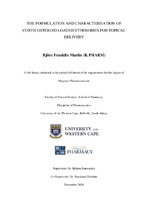| dc.description.abstract | Background/Introduction: Atopic dermatitis (AD) is one of the most prevalent diseases worldwide. It is a rapidly growing field of study with several research avenues to explore its pathophysiology and to find innovative treatment and management regimens. Clinically, it is classified as a non-contagious, intensely pruritic, inflammatory, chronic skin disorder mediated by abnormalities associated with atopy. Symptoms include inflammation, redness, pain and a negative impact on the patient‘s overall quality of life. Chronic itching often leads to the formation of lichenified skin, which may increase the thickness of the epidermis and exacerbate the barrier function of the skin. AD is treated with topical corticosteroids which help to decrease inflammation. However, lichification of the skin may decrease the efficacy of topical dosage forms. Nanomedicine is a rapidly developing field where advances have been made using ethosomes for topical delivery. As such, corticosteroid loaded ethosomal formulations containing hydrocortiosone acetate (HCA) and betamethasone valerate (BMV) were developed and characterised to develop novel tools for topical drug delivery. Aim: This study aimed at developing corticosteroid loaded ethosomes as a pre-formulation component for inclusion in a topical dosage form. To date, no ethosmal formulation with HCA and BMV has been investigated for topical drug delivery. Method: Ethosomes were synthesised using the hot method and the cold method, a modified version of a double emulsion (o/w/o), solvent evaporation technique, as developed by Touitou et al, 2007.1 Ethosomes were prepared using fixed concentrations of either BMV or HCA (10 mg/ml), ethanol (30% v/v) and purified water (70% v/v) and were comminuted using bath sonication or mini-extrusion. Centrifugation and centrifugal drying were used to purify and isolate the ethosomes for solid state characterisation. The morphology was determined using Scanning electron microscopy (SEM). Ethosomes were characterised using: dynamic light scattering (DLS), Fourier-transform infrared spectroscopy (FTIR), hot stage microscopy (HSM), differential scanning calorimetry (DSC) and thermogravimetric analysis (TGA). The encapsulation efficiency (EE) and drug loading (DL) were determined using validated HPLC methods. Finally, the drug release was determined using Franz diffusion cells and mathematical models were fitted to the % cumulative release data to determine the release kinetics. Results: Ethosomes were assessed according to the following criteria for topical drug delivery which were determined using dynamic light scattering (DLS): Hydrodynamic diameter (HdD), ~ 200 nm, polydispersity index (PdI) < 0.5 and zeta potential (ζp) ± 30 mV. The optimum formulations contained phosphatidylcholine (PC) 50 mg/ml. Extrusion was found to be the best method for particle reduction based on the reproducibility of the results. The HdD was 163.8±31.99 and 147.7±19.91 for BMV loaded ethosomes and HCA loaded ethosomes respectively and both formulations had an acceptable PdI of 0.049 and 0.111, respectively. SEM analyses indicated that the ethosomes had a spherical shape. Encapsulation of the APIs was verified by the thermoanalyses and possible intermolecular interactions were identified using FTIR. BMV loaded and HCA loaded ethosomes had a respective EE of 74.57 % and 37.30 %, and a DL of 14.91 % and 7.46 %, respectively. The release kinetics best fit the Peppas-Sahlin model indicative of an anomalous non-Fickian diffusion coupled with polymer relaxation and zero order release. Conclusions: BMV and HCA loaded ethosomes for topical drug delivery were successfully synthesised and characterised. These novel nanoparticles have provided an array of avenues for further investigation and application in the topical delivery of corticosteroids | en_US |

